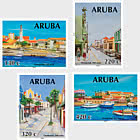The Aruban Burrowing Owl / Athene cunicularia arubensis (Length 20 cm), known locally as ‘Shoco’, is an endemic sub-species of Burrowing Owl that occurs only on Aruba.
This small, pale buffish-colored owl with lighter spots is unmistakable because of its large round yellow eyes, prominent white eyebrows, long legs, short stubby tail, and a flat facial disc typical of the owl family and lacks ear tufts.
Burrowing Owls get their common name from their unusual habit of nesting underground in already dug-out burrows, although they are known to occasionally dig out their own for nesting and sleeping. When the breeding season is over, the owls continue to use the burrows to rest during the day. Unlike most owl species, Burrowing Owls are often active during the day, although they hunt for food at night. They hunt during a 24-hour period especially when they have the young to feed.
Aruban Burrowing Owls are typically seen sitting in small family groups in areas of cactus scrub or dry forest. They are often found sitting close to the nest entrance, winking comically at any intruder and bobbing up and down when excited or in distress, veering on their long legs. Finally they will fly away and find a safer place on top of a cactus, electrical wire or large boulder.
The Burrowing Owls are very vocal, and have a wide range of different calls. They make a tremulous chuckling or chattering call.
Nesting season begins in late March or April. Occasionally a male will have two (2) mates. During the nesting season, burrowing owls will collect a wide variety of materials to line their nest, some of which are left around the entrance to the burrow.
The Aruban Burrowing Owl also lives in the National Park Arikok and can be found alongside a mostly dry riverbed and in the tonalite area in the southern and western part of the park. They are not only found out in the countryside, but also amongst people within highly developed areas.
Although they are expert diggers they sometimes do it the easy way and use discarded construction pipes as a nesting place.
They feed on large insects and rodents which it typically hunts for from the ground, walking, hopping or running after it. It is known on occasion to locate prey from a high perch and they use their talons to catch their prey, such as large insects in the air.
The Aruban Burrowing Owl’s population has greatly diminished and is now endangered, with estimates of less than 200 pairs remaining. Threats include over-development and the invasive boa constrictor. Efforts are being made to ensure that it does not go extinct.
The ‘Shoco’ was made one of Aruba’s National Symbols on February 2012. It also appears on Aruba’s Postal Stamps and Currency. The year 2012 was declared to be the year of the ‘Shoco’ and for the Aruban Burrowing Owl to be nominated as Aruba’s National Bird. The island’s terrestrial protected area, Parke Nacional Arikok, is also an important refuge where the population can recover. The Park staff is actively involved in conservation efforts.




































